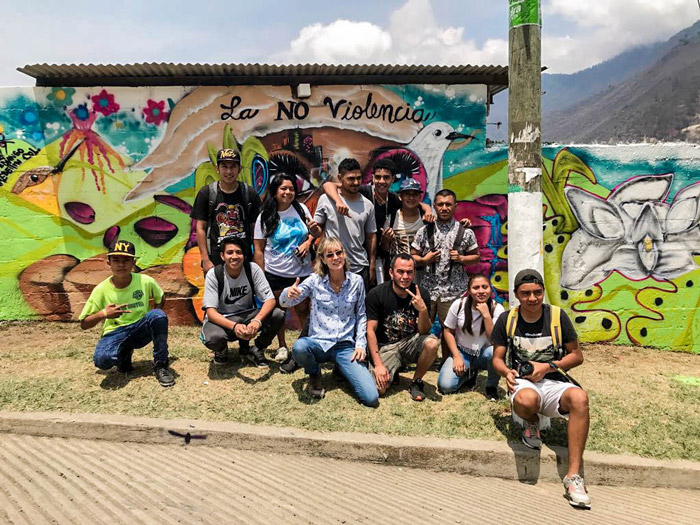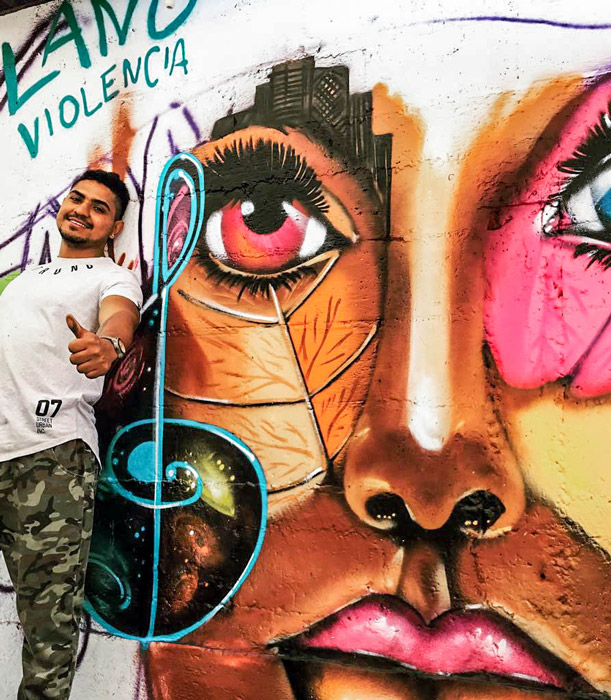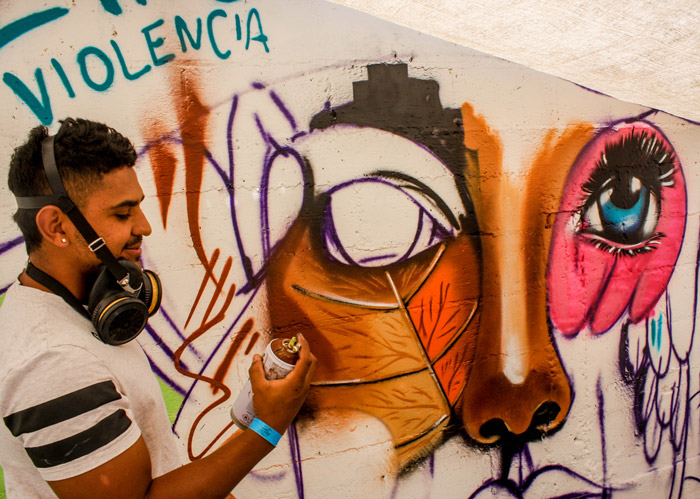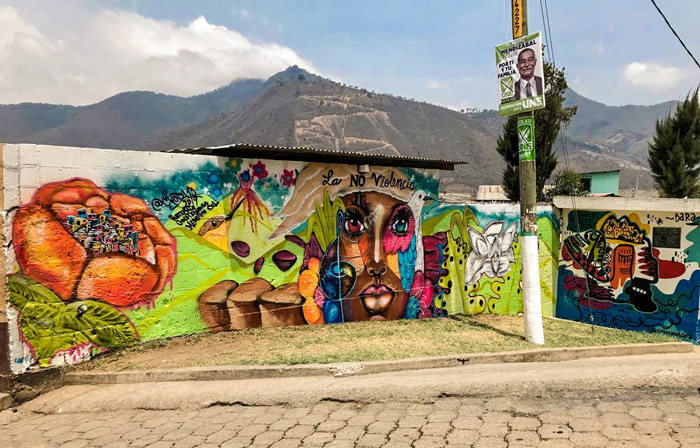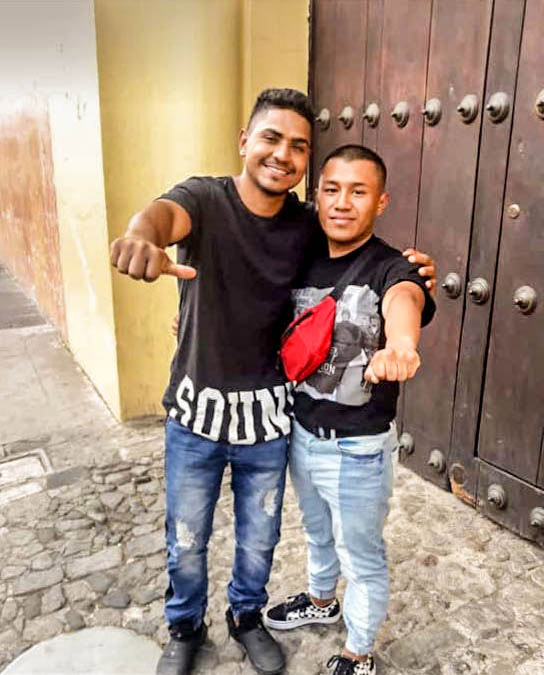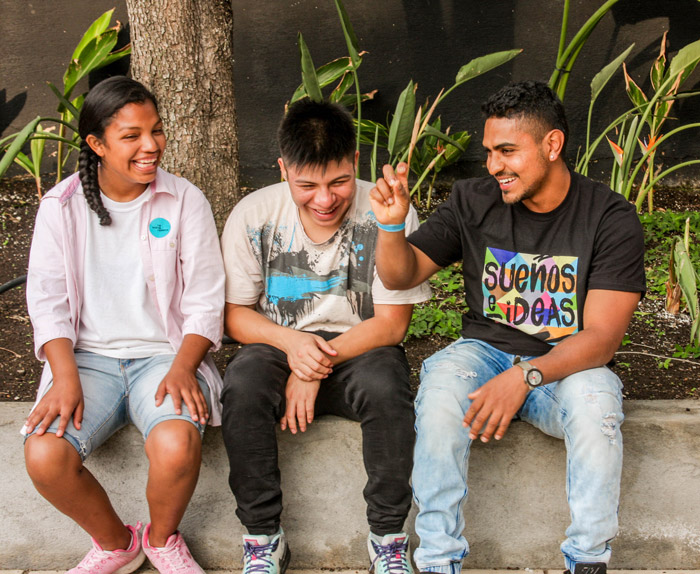Using Street Art to Empower at-risk youth in Guatemala
The streets were buzzing with excitement when news hit that John Alexander Serna, a renowned Colombian street artist aka ‘Chota,’ would be part of a team to help kick start an urban renewal initiative in Jocotenango.
Our tuk-tuk zigzagged around a steep hill until we reached ‘aldea’ Vista Hermosa, one of four barrios that comprise the community of Jocotenango, a busy suburb of La Antigua, Guatemala. Vegetation in this area is dominated by the jocote tree, which bears a small red, plum like fruit common to this part of Central America. Hence the town’s namesake, Jocotenango.
Vista Hermosa, which means ‘beautiful view’ in Spanish, was on this day the official site of an event called LANOviolencia. Chota, a visiting artist from Medellín, Colombia was here to paint a street mural and we were about to witness its creation and hopefully, the launch of a promising new program.
Volcanoes and mountains, dense with vegetation, swirl up all around Vista Hermosa revealing hillsides barren of cultivation and brown from a lack of rain. Most of the people in this hamlet live in poorly constructed brick houses covered by roofs made of galvanized lamina.
In a country traumatized by poverty, violence and migration, it has become ever more challenging for Guatemalan youth to find good paying jobs or opportunities to deter them from a life of crime and violence.
“Linking urban art with no violence gives kids a voice in their community,” said Katie Cunningham Pokorny, a staunch advocate for human and animal welfare rights and nonviolence. She is also the founder of Lead-Up International, a cutting-edge program that uses equine-assisted therapy to help at-risk youth learn to control their breathing, emotions and body language.
It was during a visit to Medellín, Colombia last year when Pokorny took a graffiti tour, met Chota and invited him to Guatemala in the hope that he could inspire the community in Vista Hermosa. “LANOviolencia will give Jocotenango more visibility and a better identity,” stated Pokorny. “We are hoping this event can become a movement and that Vista Hermosa and Chota’s barrio, Comuna 13 in Medellín, Colombia might even become sister cities one day. It’s a big dream of ours!”
“There is still a misconception out there that graffiti is somehow a bad thing,” said Chota, an inspiring yet humble twentysomething artist who was born and raised in one of the toughest neighborhoods in Medellín, Colombia – la Comuna 13. In 2012, crime had reached such dangerous levels that the government of Colombia intervened and initiated an urban renewal project in this barrio to contain the violence.
“Many of my friends wound up dead or in jail,” he lamented. “I didn’t want that for myself or my community but I knew deep down that my art could save me.” Sadly, Chota recalls how many of his teachers were impatient when kids were doodling in their notebooks because they didn’t see the connection to a free form of expression. If he could give teachers just one piece of advice, Chota would tell them not to dismiss casual drawing or ‘doodling’ as a waste of time or sign of disrespect but rather to view it as the potential birth of a creative new talent.
In Latin America, graffiti is most often associated with freedom of expression that manifests in the form of challenging the establishment or society. The street art that emerged in Brazil for example just five years ago in protest of the World Cup is analogous to that of the Buenos Aires movement in 2001 when the Argentine economic crisis began. Many people protested by painting graffiti. But in Argentina, it was more of a social experiment in which graffiti artists wanted to make people happy. Their art wasn’t created for egoistical purposes but rather to help people by making the street a more fun place to be.
Now, just seven years after the project’s inception, Comuna 13 in Medellín, Colombia is recognized internationally as an example of how innovative programs in social urbanization can turn around and revitalize communities. Chota’s street art is a major contribution to that transformation. “If we have a dream, we can make it a reality,” said Chota.
“In Jocotenango, we don’t have many outdoor areas where we can assemble and do things together,” said Denilson Larios, a community leader who works in the Antigua area with at risk youth. There aren’t many opportunities for good jobs and kids can easily turn to gangs for validation.” According to Larios, some of the best street artists come from poorer communities. “Urban transformation brings people together by celebrating community for what it is and creating hope for a better life,” he stated. “Art can literally change people’s lives.”
Over the coming months, Larios will be visiting Chota in Medellín to learn more about urban planning and to observe first hand some of the positive outcomes that have been achieved thus far in Comuna 13. It’s part of an exchange program to further motivate and strengthen ties between the two communities and to help promote the LANO-violencia initiative.
Chota’s visit culminated in a presentation and panel discussion at La Neuva Fábrica, Antigua, Guatemala’s newest, state of the art, culture center.
Prominent community members, artists and collaborators of the LANOviolencia event took part in the discussion. One of these, a life-long activist and artist, Sandra Arizandieta “Ariz” is the founder of Niñas Furia, an organization based in Guatemala City that promotes and creates urban street projects. “Art gives me access to young people so that I can help those in marginalized communities who might otherwise be ignored or turn to violence,” she explained. “We work in groups and use art as a vehicle to communicate important messages to our youth.”
Sponsorship opportunities, you may call
502- 5482 6323 in Guatemala.
People may also donate directly to
Asociación Equipo de Apoyo,
Banco Agromercantil no: 30-2011204-4.
REVUE magazine article by Kerstin Sabene.
